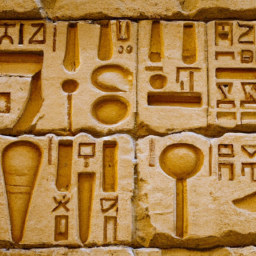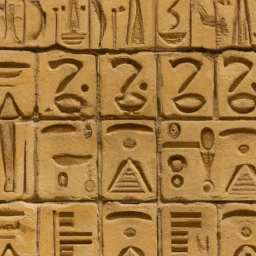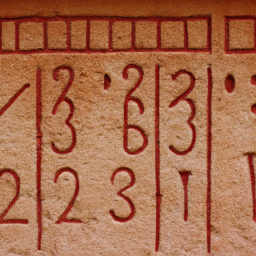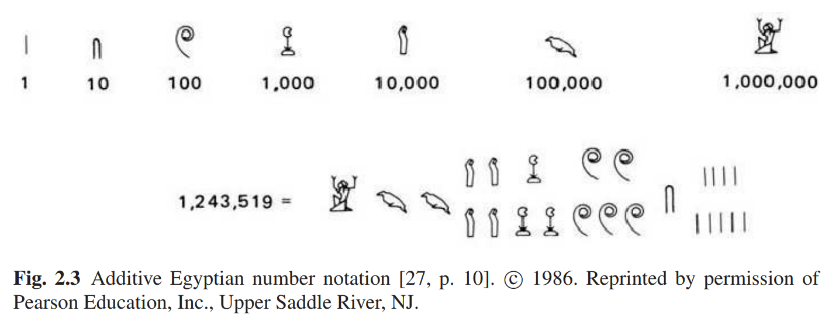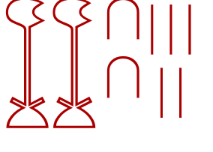Converting integer numbers to Egyptian hieroglyphs numbers.
In[]:=
ImageSynthesize"Ancient Egyptian wall with hieroglyphs number 2025 as '𓆽𓎇𓏾' UTF-8 characters",3
Out[]=
,
,
Inspired by this image from the book, and just for fun:
Algorithmic Composition, Paradigms of Automated Music Generation, Gerhard Nierhaus 2.2 Development of Symbol, Writing System and Numeral System
And facing that we have all ancient Egyptian characters at UNICODE (UTF-8)...
We set a simple list with rules of number to Egyptian character UTF-8 string:
In[]:=
egyptianNumbers=0->"",1->"𓏺",2->"𓏻 ",3->"𓏼",4->"𓏽",5->"𓏾",6->"𓏿",7->"𓐀",8->"𓐁",9->"𓐂",10->"𓎆",20->"𓎇",30->"𓎈",40->"𓎉",50->"𓎊",60->"𓎋",70->"𓎌",80->"𓎍",90->"𓎎",100->"𓏲",200->"𓍣",300->"𓍤",400->"𓍥",500->"𓍦",600->"𓍧",700->"𓍨",800->"𓍩",900->"𓍪",500->"𓍫",1000->"𓆼",2000->"𓆽",3000->"𓆾",4000->"𓆿",5000->"𓇀",6000->"𓇁",7000->"𓇂",8000->"𓇃",9000->"𓇄",10000->"𓂭",20000->"𓂮",30000->"𓂯",40000->"𓂰",50000->"𓂱",60000->"𓂲",70000->"𓂳",80000->"𓂴",100000->"𓆐",200000->"𓆐𓆐",300000->"𓆐𓆐𓆐",400000->"𓆐𓆐𓆐𓆐",500000->"𓆐𓆐𓆐𓆐𓆐",600000->"𓆐𓆐𓆐𓆐𓆐𓆐",700000->"𓆐𓆐𓆐𓆐𓆐𓆐𓆐",800000->"𓆐𓆐𓆐𓆐𓆐𓆐𓆐𓆐",900000->"𓆐𓆐𓆐𓆐𓆐𓆐𓆐𓆐𓆐",90000->"𓂵",50000->"𓂶",1000000->"𓁏"
In[]:=
0"",1"𓏺",2"𓏻 ",3"𓏼",4"𓏽",5"𓏾",6"𓏿",7"𓐀",8"𓐁",9"𓐂",10"𓎆",20"𓎇",30"𓎈",40"𓎉",50"𓎊",60"𓎋",70"𓎌",80"𓎍",90"𓎎",100"𓏲",200"𓍣",300"𓍤",400"𓍥",500"𓍦",600"𓍧",700"𓍨",800"𓍩",900"𓍪",1000"𓆼",2000"𓆽",3000"𓆾",4000"𓆿",5000"𓇀",6000"𓇁",7000"𓇂",8000"𓇃",9000"𓇄",10000"𓂭",20000"𓂮",30000"𓂯",40000"𓂰",50000"𓂱",60000"𓂲",70000"𓂳",80000"𓂴",90000"𓂵",100000"𓆐",200000"𓆐𓆐",300000"𓆐𓆐𓆐",400000"𓆐𓆐𓆐𓆐",500000"𓆐𓆐𓆐𓆐𓆐",600000"𓆐𓆐𓆐𓆐𓆐𓆐",700000"𓆐𓆐𓆐𓆐𓆐𓆐𓆐",800000"𓆐𓆐𓆐𓆐𓆐𓆐𓆐𓆐",900000"𓆐𓆐𓆐𓆐𓆐𓆐𓆐𓆐𓆐",1000000"𓁏"
We can use replace to convert the numbers:
In[]:=
{0,1,2,3}/.{1->0,2->-5,3->-3}
Out[]=
{0,0,-5,-3}
And we can use NumberExpand to break down the integer number to its distinct decimal powers parts:
In[]:=
NumberExpand[111]%/.egyptianNumbersStringJoin[%]
Out[]=
{100,10,1}
Out[]=
𓏲,𓎆,𓏺
Out[]=
𓏲𓎆𓏺
In[]:=
NumberExpand[2025]%/.egyptianNumbersStringJoin[%]Rasterize[Style[%,Bold,120,Darker[Red]]]
Out[]=
{2000,0,20,5}
Out[]=
𓆽,,𓎇,𓏾
Out[]=
𓆽𓎇𓏾
Out[]=
A test with the number from the book chapter:
In[]:=
NumberExpand[1243519]%/.egyptianNumbersStyle[StringJoin[%," "],Orange,50]
Out[]=
{1000000,200000,40000,3000,500,10,9}
Out[]=
𓁏,𓆐𓆐,𓂰,𓆾,𓍦,𓎆,𓐂
Out[]=
𓁏𓆐𓆐𓂰𓆾𓍦𓎆𓐂
Some more random testes to check the number generator:
In[]:=
Map[#/.egyptianNumbers&,NumberExpand[RandomInteger[{1,1000000},20]],2]//Column
Out[]=
𓆐𓆐𓆐𓆐𓆐𓆐𓆐𓆐𓆐,𓂳,𓆿,𓍪,𓎌,𓐂 |
𓆐𓆐𓆐𓆐,𓂴,𓆾,𓍪,𓎍,𓏾 |
𓆐𓆐𓆐𓆐𓆐𓆐𓆐𓆐,𓂴,𓆼,𓍧,𓎊,𓏺 |
𓆐𓆐𓆐𓆐𓆐,𓂭,𓆾,𓍦,𓎊, |
𓆐𓆐𓆐𓆐𓆐,𓂯,𓆼,𓍥,𓎊,𓐁 |
𓆐𓆐,𓂲,𓇁,𓍩,𓎎,𓐂 |
𓆐𓆐,𓂭,𓇃,,,𓏽 |
𓆐𓆐𓆐,𓂲,𓇄,𓏲,𓎋,𓐁 |
𓆐𓆐,𓂵,𓇂,𓍩,𓎊,𓏿 |
𓆐𓆐𓆐𓆐𓆐,𓂵,𓆼,𓍦,𓎉,𓏺 |
𓆐𓆐𓆐𓆐,𓂮,,,𓎎, |
𓆐𓆐𓆐𓆐𓆐,𓂯,𓆽,,𓎉, |
𓆐𓆐𓆐𓆐𓆐𓆐𓆐𓆐,𓂰,,𓍥,𓎆,𓐀 |
𓆐,𓂱,𓇁,𓏲,𓎍,𓏼 |
𓆐𓆐𓆐𓆐𓆐𓆐𓆐𓆐,𓂭,𓇁,𓍤,𓎋,𓏼 |
𓆐𓆐𓆐𓆐𓆐,𓂮,𓇂,𓍥,𓎍,𓐂 |
𓆐𓆐𓆐𓆐𓆐𓆐𓆐𓆐,𓂯,𓆽,𓏲,𓎊,𓏼 |
𓂳,𓇃,𓍤,𓎆,𓏺 |
𓆐𓆐𓆐𓆐𓆐𓆐,𓂯,,𓍨,𓎈,𓏽 |
𓆐𓆐𓆐𓆐𓆐𓆐𓆐𓆐𓆐,𓂲,𓆿,𓍩,𓎊,𓏺 |
And more, with decimal integer number and the one in hieroglyph Egyptian ancient notation:
In[]:=
Grid[{First[#],StringJoin[Last[Map[Last[#]/.egyptianNumbers]]]}&/@({#,NumberExpand[#]}&/@RandomInteger[{1,1000000},20])]
Out[]=
189420 | 𓆐𓂴𓇄𓍥𓎇 |
409139 | 𓆐𓆐𓆐𓆐𓇄𓏲𓎈𓐂 |
460036 | 𓆐𓆐𓆐𓆐𓂲𓎈𓏿 |
635893 | 𓆐𓆐𓆐𓆐𓆐𓆐𓂯𓇀𓍩𓎎𓏼 |
602368 | 𓆐𓆐𓆐𓆐𓆐𓆐𓆽𓍤𓎋𓐁 |
445371 | 𓆐𓆐𓆐𓆐𓂰𓇀𓍤𓎌𓏺 |
425954 | 𓆐𓆐𓆐𓆐𓂮𓇀𓍪𓎊𓏽 |
402947 | 𓆐𓆐𓆐𓆐𓆽𓍪𓎉𓐀 |
9826 | 𓇄𓍩𓎇𓏿 |
797248 | 𓆐𓆐𓆐𓆐𓆐𓆐𓆐𓂵𓇂𓍣𓎉𓐁 |
637555 | 𓆐𓆐𓆐𓆐𓆐𓆐𓂯𓇂𓍦𓎊𓏾 |
900078 | 𓆐𓆐𓆐𓆐𓆐𓆐𓆐𓆐𓆐𓎌𓐁 |
633833 | 𓆐𓆐𓆐𓆐𓆐𓆐𓂯𓆾𓍩𓎈𓏼 |
794000 | 𓆐𓆐𓆐𓆐𓆐𓆐𓆐𓂵𓆿 |
250435 | 𓆐𓆐𓂱𓍥𓎈𓏾 |
558460 | 𓆐𓆐𓆐𓆐𓆐𓂱𓇃𓍥𓎋 |
327878 | 𓆐𓆐𓆐𓂮𓇂𓍩𓎌𓐁 |
413505 | 𓆐𓆐𓆐𓆐𓂭𓆾𓍦𓏾 |
387307 | 𓆐𓆐𓆐𓂴𓇂𓍤𓐀 |
618718 | 𓆐𓆐𓆐𓆐𓆐𓆐𓂭𓇃𓍨𓎆𓐁 |
There are some variants we are not supporting, such as:
𓎐 for 30
𓎑 for 40
𓎒 for 50
and so on...
𓎑 for 40
𓎒 for 50
and so on...
I checkered some number at this conversion site, for double checking:
I found a list of those hieroglyphs Unicode UTF-8 characters at this page:
Any hint to improve it it is very welcome!
Any archeologist or Egyptologist review would be great!
Any archeologist or Egyptologist review would be great!
I am not sure if it gonna work for number > 1M, and I am not suer if it make sense for old Egypt math those bigger numbers.
I hope it is no offensive initiative for Tutankhamun Pharaoh to compute hieroglyphs.
Next step: publish as a function.
References
References
CITE THIS NOTEBOOK
CITE THIS NOTEBOOK
Simple Egyptian hieroglyphs number conversion
by Daniel Carvalho
Wolfram Community, STAFF PICKS, April 23, 2025
https://community.wolfram.com/groups/-/m/t/3448536
by Daniel Carvalho
Wolfram Community, STAFF PICKS, April 23, 2025
https://community.wolfram.com/groups/-/m/t/3448536
